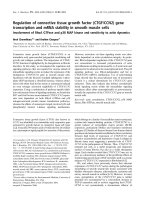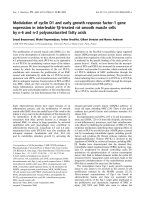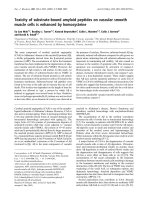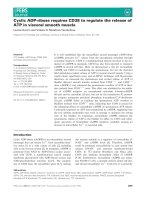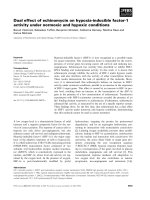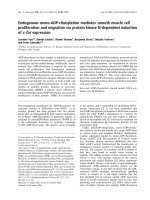DIFFERENTIATION AND CONTRACTILITY OF COLON SMOOTH MUSCLE UNDER NORMAL AND DIABETIC CONDITIONS
Bạn đang xem bản rút gọn của tài liệu. Xem và tải ngay bản đầy đủ của tài liệu tại đây (22.82 MB, 124 trang )
DIFFERENTIATION AND CONTRACTILITY OF COLON SMOOTH MUSCLE
UNDER NORMAL AND DIABETIC CONDITIONS
Ketrija Touw
Submitted to the faculty of the University Graduate School
in partial fulfillment of the requirements
for the degree
Doctor of Philosophy
in the Department of Cellular and Integrative Physiology,
Indiana University
May 2011
ii
Accepted by the Faculty of Indiana University, in partial
fulfillment of the requirements for the degree of Doctor of Philosophy.
________________________________________
B. Paul Herring, Ph.D., Chair
________________________________________
Patricia J. Gallagher, Ph.D.
Doctoral Committee
________________________________________
Simon J. Rhodes, Ph.D.
February 15, 2011
________________________________________
Robert V. Considine, Ph.D.
iii
Dedication
I would like to dedicate this dissertation to my daughter Emilia, my husband
Daniel, my mom Rasma and my brother Edmunds.
To Emilia, you have been a big part of my life through my study years. You have
brought a great joy to my life. I could not wish for a better daughter than my little
sweet girl. With my work I hope to encourage you to do great things in your life
whatever you decide to do in the future.
To Daniel, your love and support through these years have been invaluable for
me. It have been comforting to know that as challenging my day can be I can
always relay on your good attitude and understanding. Your passion for life,
work, music and anything you do have been inspirational for me. It is a joy to be
around you and share my life with you. I could not have done it without you.
To my mom, you have always been a loving and caring person. I will always
appreciate your support for me. You have shown me how much hard work
matters and have set standards for how to be a great working mother. I can not
be more thankful for everything you have done for me.
To Edmunds, it is a great joy to have such a great brother with such big heart. I
know that you will always walk an extra mile for me.
iv
Acknowledgments
First and foremost, I would like to thank my advisor, Dr. B. Paul Herring, for the
guidance through my studies. Through the years from when I was working as
technician and later as a graduate student, I have received great support in my
scientific work and also on a personal level. In Paulʼs lab I have received great
mentorship and advice during the progression of my project. Paulʼs guidance and
support through the many challenges encountered through my project have been
invaluable and have helped me to become a more independent scientist. I will
always be grateful for the opportunity to be part of the Herring lab.
I would also like to thank my committee members Dr. Patricia Gallagher, Dr.
Simon Rhodes and Dr. Robert Considine. I appreciate the time and thoughtful
advice that I have received through my studies. Your challenging questions have
helped me to develop critical thinking and have been invaluable for my scientific
advancement.
I would also like to thank our collaborators who have been very helpful with their
expert insight and have allowed me to use their equipment. Dr. Jonathan Tune
and his lab have been very helpful with contractility studies and generously
allowed me to use their equipment numerous times. I would like to acknowledge
Dr. Alexander Obukhov and Dr. Saikat Chakraborty for your expertise in calcium
imaging and many hours spent for accomplishing this part of the study. I am also
grateful for Dr. Susan Gunstʼs and Dr. Wenwu Zhangʼs help with myosin
phosphorylation studies. I would also like to thank Dr. Yun Laing and Huisi Ai for
performing CT scan study.
I am very honored and thankful for the financial support I have received from NIH
Diabetes and Obesity T32 training program. It has been very helpful for my
career through these years.
v
I would like to sincerely thank current and former Herring and Gallagher lab
members for your collegiality and fun times shared. Especially I would like to
thank Herring lab members April Hoggatt for training me when I first joined the
lab, Dr. Min Zhang and Dr. Jiliang Zhou for your help and advice, Meng Chen, Dr.
Jury Kim and Rebekah Jones for your contributions to my work and your
friendship. I would also like to say special thanks to Dr. Ryan Widau and Dr.
Emily Blue from Gallagher lab for all you advice and friendship. It has been truly
great to be part of such a great work environment.
I would like to thank my husband Daniel and his family Daniel, Nancy, Jennifer,
Sergio, Christopher, Ian and Sophia for all their support and acceptance of me. It
has been a great pleasure to have such a wonderful new family in United States.
I would like to thank my daughter Emilia for being patient at times when I have to
work. I would also like to thank my Latvian family - my parents Rasma and
Raimonds, my brother Edmunds, his wife Dina, and my grandparents Emilija,
Katrina and Leokadija. Each of you has contributed to my growth at different
times through my life and your encouragement has let me to believe in myself
and achieve my goals in life.
vi
Abstract
Ketrija Touw
DIFFERENTIATION AND CONTRACTILITY OF COLON SMOOTH MUSCLE
UNDER NORMAL AND DIABETIC CONDITIONS
Intestinal smooth muscle development involves complex transcriptional
regulation leading to cell differentiation of the circular, longitudinal and muscularis
mucosae layers. Differentiated intestinal smooth muscle cells express high levels
of smooth muscle-specific contractile and regulatory proteins, including telokin.
Telokin is regulatory protein that is highly expressed in visceral smooth muscle.
Analysis of cis-elements required for transcriptional regulation of the telokin
promoter by using hypoxanthine-guanine phosphoribosyltransferase (Hprt)-
targeted reporter transgenes revealed that a 10 base pair large CC(AT)
6
GG cis-
element, called CArG box is required for promoter activity in all tissues. We also
determined that an additional 100 base pair region is necessary for transgene
activity in intestinal smooth muscle cells. To examine how transcriptional
regulation of intestinal smooth muscle may be altered under pathological
conditions we examined the effects of diabetes on colonic smooth muscle.
Approximately 76% of diabetic patients develop gastrointestinal (GI) symptoms
such as constipation due to intestinal dysmotility. Mice were treated with low-
dose streptozotocin to induce a type 1 diabetes-like hyperglycemia. CT scans
revealed decreased overall GI tract motility after 7 weeks of hyperglycemia.
Acute (1 week) and chronic (7 weeks) diabetic mice also had decreased
potassium chloride (KCl)-induced colon smooth muscle contractility. We
hypothesized that decreased smooth muscle contractility at least in part, was due
to alteration of contractile protein gene expression. However, diabetic mice
showed no changes in mRNA or protein levels of smooth muscle contractile
proteins. We determined that the decreased colonic contractility was associated
with an attenuated intracellular calcium increase, as measured by ratio-metric
vii
imaging of Fura-2 fluorescence in isolated colonic smooth muscle strips. This
attenuated calcium increase resulted in decreased myosin light chain
phosphorylation, thus explaining the decreased contractility of the colon. Chronic
diabetes was also associated with increased basal calcium levels. Western
blotting and quantitative real time polymerase chain reaction (qRT-PCR) analysis
revealed significant changes in calcium handling proteins in chronic diabetes that
were not seen in the acute state. These changes most likely reflect
compensatory mechanisms activated by the initial impaired calcium response.
Overall my results suggest that type 1 diabetes in mice leads to decreased colon
motility in part due to altered calcium handling without altering contractile protein
expression.
B. Paul Herring Ph.D., Chair
viii
Table of Contents
List of Tables x
List of Figures xi
Abbreviations xiii
Chapter I: Introduction 1
Structure and functions of the colon 1
Regulation of colonic contractility 2
Differentiation and development of the colon smooth muscle 5
Smooth muscle contractile and regulatory proteins 7
Transcriptional regulation of smooth muscle 8
Regulation of smooth muscle-specific genes by
Serum response factor (SRF) 10
Approaches to generate transgenic mice for smooth muscle
promoter analysis 12
Colon smooth muscle in diabetes 14
Diabetes overview 14
Diabetes effects on the GI tract 16
Posttranslational protein modifications and contractility 19
Inflammation and contractility 20
Thesis and Rationale 21
Chapter II: Hprt-targeted transgenes provide new insights into smooth
muscle-restricted promoter activity 28
Summary 28
Introduction 29
Methods 31
ix
Results 34
Discussion 38
Chapter III: Type 1 diabetes leads to altered calcium signaling in
chronic and acute diabetic mice 55
Introduction 55
Methods 57
Results 61
Discussion 66
Chapter IV: Conclusions and future directions 87
References 96
Curriculum Vitae
x
List of Tables
Table 1 Relative expression levels of β-galactosidase transgenes 53
Table 2 Hprt-targeted transgene expression pattern 54
Table 3 Primers used for qRT-PCR 86
xi
List of Figures
Figure 1 Layers of the colon 23
Figure 2 Channels and receptors involved in colon smooth muscle calcium
signaling 24
Figure 3 Structure of the mouse mylk1 gene, mylk1 transcripts and minimal
telokin promoter schematics 25
Figure 4 Diabetes related defects of gastrointestinal tract 27
Figure 5 Telokin promoter Hprt targeting scheme 43
Figure 6 Expression of Hprt-targeted telokin 370AUG-LAC transgenes in
adult mice 45
Figure 7 Expression of Hprt-targeted telokin (-190 to +180) transgenes
during embryonic development 47
Figure 8 Expression of an Hprt-targeted SM22α transgene in adult mice 49
Figure 9 Expression of Hprt-targeted SM22α transgenes in embryonic mice 51
Figure 10 Expression of Hprt-targeted telokin 270bp (-94 to +180)
transgenes 52
Figure 11 CT scan reveals decreased GI motility in chronic diabeteic mice 71
Figure 12 Chronic diabetic mice show decreased colon contractility 72
Figure 13 Basal intracellular Ca
2+
levels are increased while the Ca
2+
response to 60mM KCl is decreased in the middle part of the
colon in chronic diabetic mice 74
Figure 14 Changes in mRNA levels and protein of calcium handling proteins
in chronic diabetic mice 76
Figure 15 Contractility in short term diabetic mice is decreased due to altered
intracellular Ca
2+
signaling 78
Figure 16 Chronic hyperglycemic mice have increased global O-glycosylation
levels while elevated O-glycosylation in vitro does not significantly
affect contractility 81
xii
Figure 17 Chronic diabetic mice show increased iNos mRNA levels in the
colon smooth muscle layer 83
Figure 18 Defects occurring at acute state in STZ-induced diabetic mice 84
Figure 19 Defects occurring at chronic state in STZ-induced diabetic mice 85
Figure 20 Sequence alignment of the telokin promoter 95
xiii
Abbreviations
ANS Autonomic nervous system
ATP Adenosine-5'-triphosphate
BB/W rats BioBreeding/Worcester type 1 diabetic rats
BMP Bone morphogenetic protein
Ca
2+
Calcium ion
Cav1.2 Voltage-dependent L-type calcium channel alpha 1C subunit
CG Celiac ganglion neurons
cGMP Cyclic guanosine monophosphate
CICR Calcium-induced calcium release
COX Cyclooxygenase
c-Src C-src tyrosine kinase
db/db mice Diabetic mice with leptin receptor deficiency
DG Dorsal ganglion
Egr-1 Early growth response factor 1
eNOS Endothelial nitric oxide synthase
ENS Enteric nervous system
ESC Embryonic stem cells
FGF Fibroblast growth factor
GI Gastrointestinal
GTP Guanosine-5'-triphosphate
HAT Hypoxanthine-aminopterin-thymidine
HBP Hexosamine biosynthetic pathway
Hh pathway Hedgehog pathway
HLA Human leukocyte antigen
Hprt Hypoxanthine-guanine phosphoribosyltransferase
IBD Inflammatory bowel disease
ICC Interstitial cells of Cajal
IGF-1 Insulin-like growth factor 1
xiv
IL Interleukin
IMG Inferior mesenteric ganglion
iNOS Inducible nitric oxide synthase
IP3 Inositol trisphosphate
KCl Potassium chloride
MAPK Mitogen-activated protein kinases
MLCK Myosin light chain kinase
MLCP Myosin light chain phosphatase
NCX Sodium-calcium exchanger
NFκB Nuclear factor kappa B
nNOS Neuronal nitric oxide synthase
NO Nitric oxide
NOD mice Non-obese diabetic mice
O-GlcNAc O-linked N-acetylglucosamine
ONOO
-
Peroxinitrate
O
s
-
Superoxide
PIP2 Phosphatidylinositol 4,5-bisphosphate
PKC Protein kinase C
PLC Phospholipase C
PLN Phopspholamban
PMCA Plasma membrane Ca
2+
ATPase
ROK Rho-associated protein kinase
RyR Ryanodine receptor
SCF Stem cell factor
SERCA Sarco/endoplasmic reticulum Ca
2+
-ATPase
Shh Sonic hedgehog
SMG Superior mesenteric ganglion
SMG-CG Superior mesenteric and celiac ganglia
SM-MHC Smooth muscle myosin heavy chain
SR Sarcoplasmic reticulum
xv
SRF Serum response factoe
STZ Streptozotocin
TGF Transforming growth factor
TNF Tumor necrosis factor
UDP-GlcNAc Uridine diphosphate N-acetylglucosamine
1
CHAPTER I
INTRODUCTION
Structure and functions of the colon
Digestive tract involved in food movement consists of the mouth, pharynx,
esophagus, stomach, small and large intestine. The colon is a part of the large
intestine and contains three smooth muscle layers – longitudinal, circular, and
muscularis mucosae (Figure 1). The longitudinal and circular smooth muscle
layers together are called the muscularis externa or muscularis propria and are
responsible for the majority of motility in the colon. The muscularis mucosae is
located at the border between the mucosal and submucosal layers, and
promotes movement of the epithelial mucosa. The main functions of the external
muscle layers are mixing, storage and propulsion of the colon contents. Mixing of
the chyme within the colon occurs through segmenting contractions of the
circular smooth muscle layer that promotes fluid and electrolyte absorption. The
colon also serves as a reservoir of the chyme during water absorption process
and until defecation of the residual material. Mass peristaltic contractions of
colonic smooth muscle play an important role in propelling the colonic contents to
the rectum for excretion. Functionally the colon is subdivided into proximal and
distal regions. Mixing, storage and removal of water and electrolytes from the
chyme occurs mainly in the proximal part of the colon. The distal part of the colon
serves as a main storage reservoir and conduit for feces.
The main function of the smooth muscle is to provide the contractile activity for
the colonʼs mixing and propulsive movements. To achieve this contractile activity
the smooth muscle expresses a unique repertoire of contractile and regulatory
proteins. Understanding how expression of these proteins is regulated under
physiological and pathological conditions is important for developing appropriate
2
therapies for diseases that affect the contractility of the intestine. The smooth
muscle contractile regulatory protein telokin is known to be highly expressed
specifically in visceral smooth muscle tissues and represents a useful target for
determining regulatory mechanisms that control expression of smooth muscle-
specific genes in normal physiological and disease states. Thus, in my thesis
research I analyzed telokin transcriptional regulation during development and in
adulthood and determined if and how this is altered in the diabetic state. Previous
studies have shown that diabetes in human patients and in different animal
models leads to colon dysmotility. My research was aimed at determining the
molecular defects that occur in colon smooth muscle during diabetes and what
role telokin plays in the development of motility dysfunction associated with the
disease.
Regulation of colonic contractility
Colon smooth muscle contractility is controlled by pacemaker cells within the
intestinal wall and by the autonomic nervous system (ANS) and enteric nervous
system (ENS). The ANS consists of sympathetic and parasympathetic nerve
fibers which can either directly modulate the activity of intestinal smooth muscle
or can synapse with neurons of the ENS. The ENS is subdivided into two
interconnected plexuses, the myenteric (Auerbach) plexus located in the
muscularis externa and the submucosal (Meissner) plexus. The neurons in the
myenteric plexus primarily regulate contractility of the smooth muscle whereas
the neurons in the submucosal plexus primarily regulate the activity of the
mucosal epithelial cells. Interstitial cells of Cajal (ICC) are enteric pacemakers
that mediate the basic electrical rhythm within the intestine [1]. The slow wave
depolarization induced by the ICCs are transmitted to and through the intestinal
smooth muscle cells via GAP junctions. Neurotransmission from nerves to
smooth muscle can allow these slow waves to reach threshold and fire off action
3
potentials thus opening plasma membrane calcium channels to initiate
contraction. Alternatively, neurotransmitters can direct pharmacomechanical
coupling to induce intracellular calcium release via a receptor-inositol
trisphosphate (IP3) pathway. Vagal parasympathetic nerves from the medulla
oblongata innervate the upper GI tract down to the proximal part of the colon.
The parasympathetic nerves from sacral region of the spinal chord innervate the
distal part of the colon via the pelvic nerves. In general, activation of
parasympathetic nerves stimulate secretion and promotes motility. Sympathetic
nerves from the superior mesenteric ganglion (SMG) and inferior mesenteric
ganglion (IMG) innervate proximal and distal parts of the colon, respectively.
Sympathetic nerve terminals mainly synapse with the ENS, however some of
them terminate directly on smooth muscle [2]. Sympathetic nerves usually have
inhibitory effects on GI smooth muscle motility.
Contraction of GI smooth muscle can be regulated by electromechanical or
pharmacomechanical coupling. During electromechanical coupling GI smooth
muscle contraction occurs following voltage dependent activation of L-type
calcium channels facilitating calcium influx across the plasma membrane [3, 4].
In contrast, during pharmacomechanical coupling neurotransmitter or hormone
binding to specific G-protein coupled receptors, stimulates phospholipase C
(PLC) activity leading to catalysis of lipid phosphatidylinositol 4,5-bisphosphate
(PIP2). Catalysis of PIP2 promotes production of two secondary messengers:
inositol trisphosphate (IP
3
) and diacylglycerol (DG). IP
3
binds to the IP3R on the
sarcoplasmic reticulum (SR), causing release of calcium into the cytosol. When
intracellular calcium rises either as a result of electromechanical or
pharmacomechanical coupling Ca
2+
binds to calmodulin and activates myosin
light chain kinase (MLCK). MLCK then phosphorylates the light chain of myosin
stimulating myosinʼs actin-activated ATPase activity and the energy released
from ATP hydrolysis results in myosin cross-bridge cycling and contraction.
4
When pharmacomechanical coupling occurs, the DG that is produced along with
IP
3
activates PKC, which phosphorylates specific target proteins that can
modulate contractility. Smooth muscle contractions can also occur in the absence
of a rise in intracellular calcium through a calcium sensitization mechanism which
occurs when myosin phosphatase activity is inhibited. For example, activation of
Ras homolog gene A (RhoA) increases Rho kinase (ROK) activity leading to
phosphorylation and inactivation of myosin phosphatase (MLCP). Conversely,
phosphorylation of telokin by PKG plays role in Ca desensitization and smooth
muscle relaxation. Telokin knock out mice showed increased sensitivity to Ca
and decreased cyclic guanosine monophosphate (cGMP)-induced relaxation
[22].
Intracellular calcium levels in smooth muscle cells are tightly regulated by
channels and receptors. Smooth muscle stimulation leads to calcium influx into
cytosol and relaxation causes calcium efflux out of the cell or uptake into SR. As
mentioned above, voltage gated L-type cannels play the major role in the influx of
calcium into the cell from the extracellular fluid (Figure 2). Calcium release from
intracellular stores can be mediated by either the IP3 receptor or the ryanodine
receptor (RyR). The IP3 receptor (IP3R) is located on the membrane of the SR
and when stimulated by IP3 triggers calcium release from the SR [4]. RyRʼs are
stimulated by cytosolic calcium and play role in calcium induced calcium release
(CIRC) from the SR into the cytosol. Following contraction it is important to
eliminate calcium from the cytosol in order to facilitate relaxation.
Sarco/endoplasmic reticulum Ca
2+
-ATPase (SERCA) is an ATP-dependent
calcium pump located on the SR that plays a significant role in the reuptake of
calcium into the SR permitting smooth muscle relaxation. SERCA activity is
regulated by the protein phospholamban (PLN). When PLN is associated with
SERCA calcium uptake into the SR is inhibited, while after dissociation from PLN,
calcium uptake is increased. In cardiac and perhaps also in smooth muscle,
phosphorylation of PLN relieves its inhibitory activity on SERCA. The plasma
5
membrane Ca
2+
ATPase (PMCA) is a transporter located in the plasma
membrane of the smooth muscle that also removes calcium from the cytoplasm
by pumping it out of the cell. The pump is activated by the hydrolysis of
adenosine triphosphate (ATP). While it has high affinity for binding calcium, the
removal of calcium out of the cell by this pump occurs at slow rate. An additional
mechanism of calcium extrusion is provided by the sodium-calcium exchanger
(NCX), an antiporter located on the smooth muscle plasma membrane. NCX
removes calcium from cells in exchange for sodium. In contrast to PMCA the
Na
+
/Ca
2+
exchanger does not bind very tightly to Ca
2+
but it can transport calcium
out of the cell rapidly.
Differentiation and development of the colon smooth muscle
Progenitors of colonic smooth muscle cells differentiate from the mesenchyme
surrounding the primitive gut epithelial tube. At early stages the primitive gut has
a tubular form and consists of undifferentiated epithelium surrounded by
undifferentiated mesenchyme. Smooth muscle development follows a rostro-
caudal progression starting in the esophagus at embryonic day 11 in mice and
moving forward toward the foregut, midgut and finally the hindgut [5, 6]. The
smooth muscle precursor cells are called myoblasts and express SM α-actin [5,
6]. In parallel to villi formation, the first layer of smooth muscle myoblasts
differentiate and give rise to the inner circular smooth muscle layer. Around
embryonic day 12 primitive crypts are formed and smooth muscle cells in the
longitudinal layer differentiate. Coincident with longidudinal smooth muscle
appearance the third smooth muscle layer muscularis mucosa forms from
mecenchyme in close proximity to the epithelium. Although the muscularis
mucosae represents an independent induction of smooth muscle it progresses
through similar differentiation pattern as circular and longitudinal smooth muscle
layers. During development, smooth muscle myoblasts rapidly differentiate into
6
smooth muscle myocytes that are immature smooth muscle cells that persist until
birth [5, 6]. Smooth muscle myocytes, in addition to expressing SM α-actin also
start to express high levels of SM γ-actin, smooth muscle myosin heavy chain
(SM-MHC), telokin and calponin from embryonic day 12-13 in mice. However, the
final differentiation and maturation of myocytes occurs only after birth.
Many signaling pathways are involved in smooth muscle differentiation during
development of gastrointestinal tract. Hedgehog (Hh) signaling is important for
radial patterning and mesenchyme differentiation into smooth muscle. Sonic
hedgehog (Shh), a member of Hh family, has been implicated in the early
development in the gut and plays role in the crosstalk between endoderm and
mesoderm. Hh ligand is released by endoderm and induces development of
smooth muscle [7, 8]. Hh is a radial morphogen and does not promote smooth
muscle development if mesenchyme is located too close or too far to the source
of the ligand [7, 8]. It also have been shown that inactivation of Hh signaling
impairs smooth muscle development [7]. In the developing gut Shh induces
expression of the Transforming growth factor β (TGFβ) family member Bone
morphogenetic protein 4 (BMP4) in the mesenchyme which is important factor in
smooth muscle development [9, 10]. BMP family members are expressed in both
mesenchyme and epithelial cells. BMP4 has been shown to play role in smooth
muscle proliferation and differentiation [11]. However, BMP2 rather than BMP4
enhanced smooth muscle differentiation from embryonic stem cells in an in vitro
gut differentiation model, as evidenced by enhanced formation of contracting gut-
like structures that expressed SM α-actin [12]. Although Wnt signaling has been
implicated in the development of epithelial cells, recent studies have also shown
role of Wnt5a in the differentiation of mesenchyme. Wnt5a knock out mice have
thinner muscularis propria, improper midgut closure, and a shortened midgut
[13]. These findings suggest that Wnt signaling plays a role not only in epithelial
cell proliferation but also mesenchyme proliferation and/or differentiation.
Fibroblast growth factors (FGF) family members also have been shown to play
7
roles in development of smooth muscle of the colon. For example, FGF-9 has
been implicated in signaling pathway that controls gut length through proliferation
and differentiation of fibroblasts [14].
Smooth muscle contractile and regulatory proteins
All differentiated smooth muscle is characterized by the presence of unique
isoforms of contractile proteins that are not expressed in other tissue types.
Examples of smooth muscle-specific proteins include smooth muscle α and γ -
actin, SM-MHC, caldesmon, SM22α, telokin and calponin. Although all of these
proteins are expressed in smooth muscle some of them are more abundant in
visceral smooth muscle while others are more abundant in vascular smooth
muscle tissue. For example, telokin and SM γ-actin are particularly abundant in
visceral smooth muscle cells [15-17] while SM22α is highly expressed in vascular
and visceral smooth muscle in adult animals [18-20]. While the physiological
functions of myosin and actin are well defined the functions of other smooth
muscle restricted proteins are less clear. The amino acid sequence of telokin is
identical to the carboxyl-terminus of the 130kDa “smooth muscle” MLCK and the
220kDa “non-muscle” form of MLCK (Figure 3). However, telokin does not
contain the kinase domain of the MLCKs and functions rather to regulate the
activity of the myosin light chain phosphatase. Telokin has been shown to
activate myosin light chain phosphatase and to be important for cGMP mediated
calcium desensitization of phasic smooth muscle tissues [21-25]. Telokin
knockout mice, generated by deleting an AT-rich region and the CArG box from
the core of the telokin promoter, exhibit increased myosin phosphatase activity,
resulting in a leftward shift in the calcium-force relationship in visceral but not
vascular smooth muscle tissues [22]. The higher level of expression of telokin in
visceral as compared to vascular and smooth muscle cells can thus account for
the lower calcium sensitivity of contraction in visceral as compared to vascular
8
tissues [21]. These findings demonstrate that differential expression of telokin in
distinct smooth muscle tissues plays an important role in regulating the
physiological properties of the tissue.
SM22α is a smooth muscle-specific protein that binds cytoskeletal actin filaments
in smooth muscle cells. SM22α knock out mice develop normally and do not
develop any cardiovascular or visceral organ problems suggesting that it is not
required for basal homeostatic functions in these tissues [26]. However, when
SM22α knock out mice were crossed into hypercholesterolemic ApoE-deficient
mice, mice developed more pronounced atherosclerotic lesions suggesting that
SM22α plays a role in smooth muscle phenotype regulation during atherogenesis
[27]. SM22α also have been implicated in calcium-independent vascular smooth
muscle contractility [28]. Similar to SM22α, calponin has been implicated in the
regulation of smooth muscle contraction through its interaction with actin and
inhibition of phosphorylated myosin [29]. Calponin acts as an actin filament-
stabilizing molecule that contributes to physiological thin filament turnover rates
in different cell types. Another actin-binding protein, caldesmon also binds
myosin, calmodulin and tropomyosin and plays a significant role in regulating
contractility by inhibiting the actomyosin ATPase activity. Caldesmon’s activity
is regulated by calcium levels and phosphorylation [30].
Transcriptional regulation in smooth muscle
Analysis of the transcriptional regulation of smooth muscle restricted genes such
as telokin and SM22α has provided important insights into the molecular
mechanisms that control smooth muscle differentiation.
We have previously shown that telokin mRNA is transcribed from a promoter
located within an intron that interrupts the exon encoding the calmodulin binding
9
domain of the MLCKs (Figure 3) [16]. Unlike the 130kDa MLCK, which has been
detected in all adult tissues examined thus far, telokin protein and mRNA
expression is restricted to adult and embryonic smooth muscle tissues and
cultured smooth muscle cells [31, 32]. Both, in adult and in embryonic mice,
telokin is expressed at higher levels in most visceral smooth muscle tissues
compared to vascular smooth muscle tissues [31]. In situ hybridization analysis
revealed that telokin expression is first detected in the gut at embryonic day 11.5.
Expression is then detected in airway and urinary smooth muscle between day
13.5 and 15.5. Induction of telokin expression during the postnatal differentiation
of the reproductive tract parallels the induction of other smooth muscle-specific
proteins. The variable levels of telokin expression, in different vascular smooth
muscle tissues, likely reflect the diverse origins of smooth muscle cells
throughout the vasculature. For example, although no telokin could be detected
in the dorsal aorta of a 14.5 day embryonic mouse, high levels of expression
could be detected in the umbilical artery [31]. The cis-acting regulatory elements
necessary to direct this pattern of telokin expression are contained within a
370bp proximal promoter region, as a reporter gene driven by this fragment was
also restricted largely to visceral smooth muscle in adult animals in vivo [33].
Analysis of SM22α gene expression reveled that endogenous SM22α is
expressed in skeletal, smooth and cardiac muscle during embryonic development
but postnatally becomes restricted to smooth muscle only [34]. SM22α is first
detected in the primitive heart tube at embryonic day 8, after embryonic day 13.5
mRNA levels decline in the heart such that no expression can be detected in
adults. Similarly, transient SM22α expression was also observed in developing
skeletal muscle between embryonic days 9.5 and 12.5. Postnatally SM22α
expression is restricted to smooth muscle tissues, although in contrast to the
endogenous SM22α which is expressed in all smooth muscle tissues, SM22α
promoter driven transgenes are restricted to vascular smooth muscle tissues [26,
35, 36]. Several reports have shown that a -441 to +62 SM22α promoter directs
10
reporter gene expression specifically to arterial smooth and not to venous or
visceral smooth muscle cells in transgenic mice [18-20, 33]. Longer promoter
fragments exhibited a similar pattern of transgene expression but a BAC clone
encompassing the entire SM22α gene was found to be expressed in all smooth
muscle tissues in transgenic mice [18, 19, 36]. These data suggest that
additional distal regulatory elements are required for SM22α promoter activity in
veins and visceral tissue.
Regulation of smooth muscle-specific genes by serum response factor
(SRF)
Serum response factor (SRF) is a widely expressed transcription factor that plays
roles in differentiation of cardiac, skeletal and smooth muscles. SRF regulates
genes by binding to a 10 bp cis-element, CC(AT)
6
GG, called the CArG box [37].
SRF have been shown to play a role in smooth muscle differentiation and smooth
muscle-specific gene expression. Mouse knockout studies have shown that SRF
is important in mesoderm differentiation during mouse embryogenesis [38].
Although SRF knock out embryonic stem (ES) cells could form mesoderm in
vitro, by an unknown mechanism, they were not able to express smooth muscle
markers [39]. These data suggest that, in addition to regulating mesoderm from
which most smooth muscle cells are derived, SRF also plays a direct role in
regulating smooth muscle differentiation. This is supported by studies which
generated a smooth muscle-specific knockout of SRF in adult tissues [40-42].
Knocking out SRF in adult smooth muscle tissues resulted in a dilated GI tract
with decreased contractility due to attenuated expression of smooth muscle
contractile proteins and a thinning of the muscularis externa. These defects led to
severe intestinal obstruction [40, 41].


